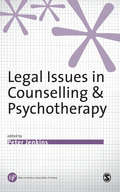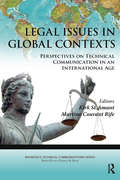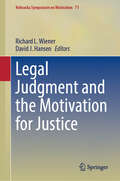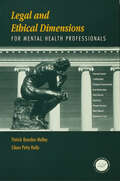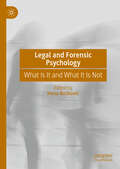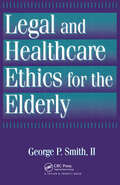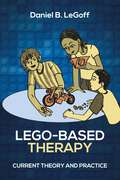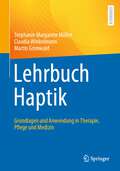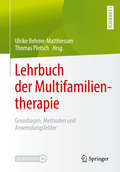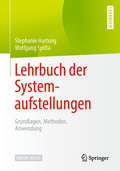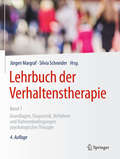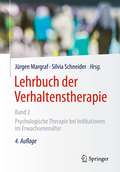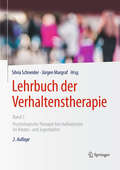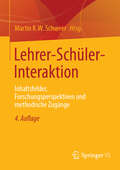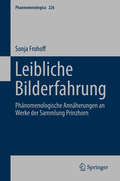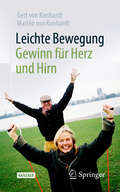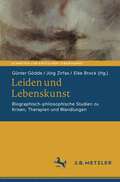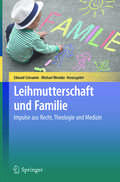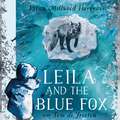- Table View
- List View
Legal Issues in Counselling & Psychotherapy (Ethics in Practice Series)
by Peter Jenkins`This is an excellent book. It builds well on Peter Jenkins′ admirable earlier contribution to our knowledge of the many legal matters that are of vital concern to counsellors (Counselling, Psychotherapy and the Law, SAGE 1997) It is mY intention, as a counsellor and lecturer to make Peter Jenkins′ new book required reading for all our students. Indeed I would go as far to say that all counsellors, not matter how experienced they consider themselves, should consider this book as essential reading. As the advert says, "don′t leave home without one!" - Norman Claringbull, Counselling at Work `This is good value for trainees and experienced practitioners alike, provoking reflection and providing a useful reference source′ - Sally Scott, Healthcare Counselling and Psychotherapy Journal Counsellors and psychotherapists are increasingly seeing the impact of legal issues on their practice and yet many feel under-prepared for the challenges they have to face. Legal Issues in Counselling & Psychotherapy is a much-needed source of advice and reference which examines the rapidly growing range of situations in which therapists find themselves in contact with the law - in their everyday practice, in specialist work, or when facing a legal case against them. The first part covers the current legal context of therapeutic work including confidentiality, contracts, data protection and court reports. Chapters include: defining work by leading writers from the therapeutic and legal worlds, as well as an illuminating account by a client who brought a successful case against her therapist. Some areas of therapeutic work are particularly circumscribed by legal issues and the second part examines the specific implications for therapists in relation to: - working with survivors of sexual abuse -working in legal settings -false memory -the Human Rights Act. Looking to the future, the book also examines the implications of professional regulation for all counsellors and psychotherapists. The need for counsellors and psychotherapists to be well informed about the law is rapidly growing. Legal Issues in Counselling & Psychotherapy therefore provides access to essential information which will be of great value to trainees, practitioners and supervisors.
Legal Issues in Global Contexts: Perspectives on Technical Communication in an International Age (Baywood's Technical Communications)
by Kirk St. Amant Martine RifeToday, it has been said, the world is "flat," as online media allow information to move easily from point to point across the earth. International legal differences, however, are increasingly affecting the ease with which data and ideas can be shared across nations. Copyright law, for example, affects the international flow of materials by stipulating who has the right to replicate or to share certain kinds of content. Similarly, perspectives on privacy rights can differ from nation to nation and affect how personal information is shared globally. Moreover, national laws can affect the exchange of ideas by stipulating the language in which information must be presented in different geopolitical regions. Today's technical communicators need to understand how legal factors can affect communication practices if they wish to work effectively in global contexts. This collection provides an overview of different legal aspects that technical communicators might encounter when creating materials or sharing information in international environments. Through addressing topics ranging from privacy rights and information exchange to the legalities of business practices in virtual worlds and perspectives on authorship and ownership, the contributors to this volume examine a variety of communication-based legal issues that can cause problems or miscommunication in international interactions. Reviewing such topics from different perspectives, the authors collectively provide ideas that could serve as a foundation for creating best practices on or for engaging in future research in the area of legal issues in international settings.
Legal Issues in Social Work Practice and Research
by Sana LoueThis highly practical text surveys the myriad legal and ethical issues that social workers encounter both in daily practice and under special circumstances. Its initial section presents concepts in law and ethics that unite practitioners, researchers, and academics in the field, such as confidentiality, informed consent, and the interplay between social work and administrative and judicial systems. A selection of representative cases illustrates legal aspects involved in providing services to families, children, elders, and persons with disabilities. Also included are chapters on advocacy in social work, both in its potential to influence policy and on the global stage as part of the ongoing struggle for human rights and dignity.Among the topics covered:Confidentiality and the social worker-client relationshipLiability issues for social workers in the clinical contextLegal issues arising in the context of social work researchThe social worker and forensic social workSocial worker involvement in access to school and school servicesSocial work in the context of health careLegal issues working with immigrants, refugees, and asyleesThe interface between social work and human rightsLegal Issues in Social Work Practice and Research is an interdisciplinary text aimed at social work, mental health, and legal professionals. It enhances the power of social work as an integrative system to support clients’ rights and agency.
Legal Judgment and the Motivation for Justice (Nebraska Symposium on Motivation #71)
by David J. Hansen Richard L. WienerThis volume takes as its point of departure that those who work in the area of law and psychology currently possess a great deal of knowledge about the psychology of the legal system, including the way in which the behavior of legislators, judges, jurors, attorneys, litigants, and defendants shapes the outcome of justice. It has also become very clear that the main obstacles to beneficial modifications to the legal system stem from the lack of motivation to seek justice, motivation to change legal process, and motivation to make use of evidence-based decision making. The purpose of this volume is to examine the antecedents of the motivation for justice, describe how that motivation activates and manifests in various legal institutions (i.e., elections, legislatures, courts, and executive offices), and trace the failure of that motivation to influence legal decision making. This will include research and commentary about a) where the motivation for justice comes from when people make legal judgments and decisions, b) how the motivation for justice influences legal judgments and decisions, and c) how legal judgments and decisions influence the motivation for justice in positive and negative ways. This topic is paramount at the current time in our history in view of the apparent breakdown of society&’s beliefs in our institutions and trust in the democratic process, which has contributed to a system that has increasingly operated from tribalistic impulse rather than from a richer motivation for authentic justice.
Legal Normativity in the Resolution of Internal Armed Conflict
by Philipp KastnerWith an estimated ninety-five percent of the world's armed conflicts occurring within individual states, resolution and prevention of internal conflicts represent a main driver of global peace. Peace negotiations stand outside the traditional formalism of lawmaking and represent a uniquely privileged moment to observe the rise or adjustment of the legal framework of a given state. Based in a socio-legal and pluralistic understanding of law, this book explores the normative dynamics of peace negotiations. It argues that the role of law in the peaceful resolution of internal armed conflicts has been greatly underestimated and that legal theory can and should contribute to a better comprehension of these processes. Including thematic case studies from Darfur, North-South Sudan, Uganda, Côte d'Ivoire, Colombia, Sri Lanka, Sierra Leone, Mozambique, Bosnia and Israel-Palestine, this volume will be of use to scholars, students and affiliates of international organizations and non-governmental organizations.
Legal and Ethical Dimensions for Mental Health Professionals
by Patrick B. Malley Eileen Petty DeklewaThe legal system's impact and influence on the mental health profession has never been greater. Whether as a witness, plaintiff, or defendant, it is likely that a professional will have some kind of interaction with the law at least once in his/her career. More than ever, it is essential that psychologists, social workers, and counselors have a working knowledge of the legal and ethical mandates to which they will be held accountable.Legal and Ethical Dimensions for Mental Health Professionals is a complete guide to the law and ethics as they relate to clinical practice. These issues can often be very confusing as values and rules change based on clients and context. For example, a school counselor who works with children is bound by different rules of confidentiality than a psychologist who counsels adults. To simplify such issues, the authors divide information into the legal and ethical rules appropriate for various types of clients in a number of settings.The book opens with an explanation of the history of law related to mental health professionals, including a description of how and why laws related to clinicians are enacted. It then focuses on the therapist-client relationship and examines the many points at which legal and ethical considerations intersect with the practice of therapy.This comprehensive look at the standards of law and ethics is essential reading for not only graduate and doctoral level students in the mental health fields, but also practicing professionals.
Legal and Forensic Psychology: What Is It and What It Is Not
by Irena BoškovićThis book seeks to distinguish empirically-based knowledge from widespread misconceptions in the fields of legal and forensic psychology. Across ten chapters, leading scholars contribute different perspectives on their areas of expertise within the fields of legal and forensic psychology, providing a comprehensive overview of the historical context and defining characteristics of these two disciplines. The first section of the book is dedicated to legal psychology, exploring issues such as pseudoscience in lie detection, the use of polygraphs, and the reliability of eyewitness testimony and memory reports in legal settings. The second focuses on forensic psychology, addressing topics such as the relationship between criminal behavior and psychopathology, symptom validity assessment, risk assessment, and the treatment of forensic patients. As such, this vital book will serve as an excellent starting point for those seeking to educate themselves about these disciplines.
Legal and Healthcare Ethics for the Elderly
by George P. Smith IIIncreasingly, legislators at the state and federal levels of government are forced to evaluate and act upon the unique problems presented by an aging American public. A domino effect has occurred, evoking concern in educational circles to deal with the varied, complex issues associated with the "new" gerontology. This expanded focus brings in not only mental and public health delivery issues, but reaches and impacts on the social sciences, ethics, law and medicine as well as public policy. In response to these matters, Legal and Healthcare Ethics for the Elderly provides a balanced analytical presentation of the complicated socio-legal, medico-ethical and political perspectives which interact with gerontology as a field of study. In a straightforward and unambiguous style, it covers information on access and financing healthcare, the ethics of rationing healthcare and the inevitable link to the quality of life, guardianship issues in a nursing home setting, informed consent, living wills and durable powers of attorney, elder abuse, and death with dignity. The economics of care giving is charted and directed by the sometimes harsh realities of the marketplace. Thus, the various philosophical and ethical dilemmas which confront the process of aging are examined here both from a micro- and from a macro-economic perspective. This book exemplifies that it is vitally important to be educated now, to be prepared for the future and thereby make informed decisions - for both ourselves and our loved ones.
Lego-Based Therapy: Current Theory and Practice
by Daniel B. LeGoffThis book provides a description of the current theory and methodology of LEGO-based therapy (LBT) for social development. It is intended for all readers who have an interest in LBT and both how and why it works to improve the development of social commun
Lehrbuch Haptik: Grundlagen und Anwendung in Therapie, Pflege und Medizin
by Stephanie Margarete Müller Claudia Winkelmann Martin GrunwaldDieses Lehrbuch vermittelt Physiotherapeuten, Ergotherapeuten, Pflegekräften und anderen Gesundheitsberufen alle wesentlichen Forschungsergebnisse zum Tastsinn und dessen Relevanz im beruflichen Alltag. Welchen Einfluss hat Berührung auf körperliche und geistige Gesundheit? Wie wirken Läsionen des zentralen Nervensystems auf die Haptik? Kann der Tastsinn trainiert werden? Die Antworten liefern Ihnen die Experten.Aus dem Inhalt:• Anatomie, Physiologie und Störungsbilder des haptischen Systems• Testung, Trainierbarkeit und Rehabilitation• Berührung als Kommunikationsmittel• Einfluss von Berührung auf Entwicklung, Stress, Schmerz, Schlaf, Immunsystem und verschiedene Krankheitsbilder, u.a. Diabetes Mellitus, Depression, ADHS oder Bluthochdruck Nutzen Sie Ihr erweitertes Wissen für noch größere Behandlungserfolge in der bio-psycho-sozialen Gesundheitsversorgung und sorgen für eine gelungene Kommunikation mit Patienten und Angehörigen!
Lehrbuch der Multifamilientherapie: Grundlagen, Methoden und Anwendungsfelder
by Ulrike Behme-Matthiessen Thomas PletschDie Multifamilientherapie (MFT) hat viele Vorteile: Menschen solidarisieren sich, indem sie erleben, nicht allein betroffen zu sein. Sie überwinden eher die schambedingte Isolation, wenn sie bei anderen ähnliche Schwierigkeiten sehen und finden schnell eine sie verbindende gemeinsame Sprache.In diesem Lehrbuch für die Aus- und Weiterbildung in Systemischer Therapie werden theoretische Grundlagen, Arbeitsmethoden und Interventionstechniken sowie die Praxis multifamilientherapeutischen Handelns kompakt und anschaulich dargestellt. Anhand zahlreicher Fallbeispiele, Definitionen, Verständnisfragen und einem Online-Karteikartensatz zum Lernen und Wiederholen geben Expertinnen und Experten einen Einblick in die Arbeit der Multifamilientherapie in unterschiedlichen Kontexten und Einsatzbereichen.
Lehrbuch der Systemaufstellungen: Grundlagen, Methoden, Anwendung
by Stephanie Hartung Wolfgang SpittaBei der Methode der Systemaufstellung handelt es sich nicht nur um ein Handwerk. Neben den eigentlichen Techniken sind spezifische Kenntnisse über die Bereiche, in denen die Methode schlussendlich angewendet wird, sowie ein Verständnis für eine systemische Haltung essentiell.Mit diesem Lehrbuch halten Sie ein Grundlagenkompendium in den Händen, welches die wesentlichen Aspekte einer Ausbildung in der Methode der Systemischen Aufstellung für den individualtherapeutischen und psychosozialen Anwendungsbereich zusammenfasst. Zahlreiche Hintergrundinformationen und praxisnahe Beispiele zu den einzelnen Lehrinhalten, eine Sammlung hilfreicher Übungen und Aufstellungsformate sowie Tipps für die Vermittlung in Aus- und Weiterbildung helfen beim Verständnis ebenso wie bei der Anwendung.Das Lehrbuch der Systemaufstellung stellt somit eine umfassende Arbeitshilfe und ein Nachschlagewerk zu allen Aspekten einer Grundausbildung in systemischer Aufstellung mit dem Fokus auf den individualtherapeutischen, psychosozialen Bereich dar.
Lehrbuch der Verhaltenstherapie, Band 1: Grundlagen, Diagnostik, Verfahren und Rahmenbedingungen psychologischer Therapie
by Jürgen Margraf Silvia SchneiderDas Standardwerk der Verhaltenstherapie für Ausbildung und Beruf. In dieser komplett überarbeiteten Neuauflage werden die Grundlagen, die Diagnostik und die Rahmenbedingungen der Verhaltenstherapie praxisrelevant und übersichtlich dargestellt. Der stringente Aufbau der einzelnen Kapitel dient der schnellen Orientierung im Text. Im Mittelpunkt stehen neben der Theorie die praktischen Voraussetzungen und die klare Darstellung des Verfahrens, inklusive der Anwendungsbereiche und seiner Grenzen. Darüber hinaus werden Wirkmechanismen und Effektivität diskutiert, weiterführende Literatur schließt jedes Kapitel ab. Das Lehrbuch richtet sich vor allem an Studenten, Ausbildungskandidaten, Praktiker und Forscher aus den Bereichen Klinische Psychologie, Psychiatrie und Psychotherapie sowie deren Nachbardisziplinen. Besonderen Wert legen Herausgeber und Autoren auf das konkrete therapeutische Vorgehen sowie die Verankerung der Therapieverfahren in der klinischen Grundlagenforschung. Um dem faszinierenden Gebiet der Verhaltenstherapie und ihrer Grundlagen gerecht zu werden, geht die Neuauflage deutlich über eine bloße Aktualisierung hinaus. Ziel ist ein praxisrelevantes Lehrbuch, das erfahrene Therapeutinnen und Therapeuten ebenso wie Anfänger mit Genuss und Gewinn lesen.
Lehrbuch der Verhaltenstherapie, Band 2: Psychologische Therapie bei Indikationen im Erwachsenenalter
by Jürgen Margraf Silvia SchneiderIn dieser komplett überarbeiteten Neuauflage werden sämtliche Störungen im Erwachsenenalter praxisrelevant und übersichtlich dargestellt.Der stringente Aufbau der einzelnen Kapitel dient der schnellen Orientierung im Text. Im Mittelpunkt stehen die allgemeine Darstellung der Störung, Modelle zu Ätiologie und Verlauf, Diagnostik, therapeutisches Vorgehen, Fallbeispiele, empirische Belege und weiterführende Literatur.Das Lehrbuch richtet sich vor allem an Studenten, Ausbildungskandidaten, Praktiker und Forscher aus den Bereichen Klinische Psychologie, Psychiatrie und Psychotherapie sowie deren Nachbardisziplinen.Besonderen Wert legen Herausgeber und Autoren auf das konkrete therapeutische Vorgehen sowie die Verankerung der Therapieverfahren in der klinischen Grundlagenforschung. Um dem faszinierenden Gebiet der Verhaltenstherapie und ihrer Grundlagen gerecht zu werden, geht die Neuauflage deutlich über eine bloße Aktualisierung hinaus. Ziel ist ein praxisrelevantes Lehrbuch, das erfahrene Therapeutinnen und Therapeuten ebenso wie Anfänger mit Genuss und Gewinn lesen.
Lehrbuch der Verhaltenstherapie, Band 3: Psychologische Therapie bei Indikationen im Kindes- und Jugendalter
by Jürgen Margraf Silvia SchneiderIn dieser komplett überarbeiteten Neuauflage werden Störungen im Kindes- und Jugendalter praxisrelevant und übersichtlich dargestellt. Der stringente Aufbau der einzelnen Kapitel dient der schnellen Orientierung im Text. Im Mittelpunkt stehen die allgemeine Darstellung der Störungen, Modelle zu Ätiologie und Verlauf, Diagnostik, therapeutisches Vorgehen, Fallbeispiele, empirische Belege und weiterführende Literatur. Das Lehrbuch richtet sich vor allem an Studierende, Ausbildungskandidaten, Praktiker und Forscher aus den Bereichen Klinische Psychologie, Kinder- und Jugendlichenpsychiatrie und -psychotherapie sowie deren Nachbardisziplinen.
Lehren und Lernen im Wandel: Innovative Wege für Schule und Unterricht im 21. Jahrhundert
by Klaus KonradDas Fachbuch richtet sich an Lehrkräfte aller Schularten, aber auch an andere Experten der pädagogischen Praxis. Es führt in Bereiche des Lehrerverhaltens ein, welche im Unterrichtsalltag bedeutsam sind. Interessierte Leser*innen erhalten Anregungen zum Verständnis und zur Gestaltung der Interaktion zwischen Lehrenden und Lernenden im System, das heißt der lernenden Organisation Schule. Kindern und Jugendlichen bessere Lern- und Lebenschancen zu ermöglichen, muss zur Leitlinie von Verbesserungsstrategien aller Beteiligten des Bildungssystems werden. Dabei liegen die wirksamsten Möglichkeiten, dies umzusetzen, in den Schulen selbst. Auf die Lehr-Lern-Szenarien und die Lehrer-Schüler-Beziehungen in unseren Klassen kommt es an. Die Dimensionen von KEYS (Keys to Excellence in Your Schools – international bewährtes Konzept der Schulentwicklung) fungieren als roter Faden des Buches. Dazu gehören Anregungen und Beispiele für eine wertschätzende, lernerorientierte und integrative Form der (Aus)Bildung. Zuallererst wollen wir es Schüler*innen ermöglichen, mit aktuellen Anforderungen zurechtzukommen und sich in Zeiten des Wandels und der Unsicherheit zu entfalten. Für Lehrpersonen von besonderem Interesse sind vermutlich vier Fragen: 1. Wie gestalte ich verstehens- und problemorientierten Unterricht?, 2. Was sind sinnvolle didaktische Reaktionen auf die vorfindbaren Begabungs und Leistungsunterschiede?, 3. Wie kann ich in Zeiten des Wandels und der Unsicherheit mit meinem Beruf zurechtkommen?, 4. Wie kann ich meinen Arbeitsplatz in einer lernenden Organisation aktiv (mit)gestalten?
Lehrer-Schüler-Interaktion: Inhaltsfelder, Forschungsperspektiven und methodische Zugänge
by Martin K. W. SchweerDer Band stellt den aktuellen Forschungsstand zu den vielfältigen Facetten der Interaktion zwischen Lehrer/innen und Schüler/innen dar. Die behandelten Inhalte sind dabei gleichermaßen für die wissenschaftliche Arbeit und die pädagogische Praxis von Interesse (u. a. Gewalt, Ängstlichkeit, Vertrauen, Intelligenz und Hochbegabung, Gender und Diversity, Medien, Unterrichtsklima, Lern- und Leistungsförderung, Konflikte, inklusive Schul- und Unterrichtsentwicklung). Kapitel 12 ist unter einer Creative Commons Attribution CC-BY 4.0 International License über link.springer.com frei verfügbar (Open Access).
Lehrmeister Ratte
by Jorunn Wissmann Kelly G. LambertVon Psychologen, Ratten und Menschen Was können uns ganz gewöhnliche Laborratten über das Menschsein verraten? Die Biopsychologin Kelly Lambert meint: sehr viel. Sie führt seit nunmehr fünfundzwanzig Jahren Forschungen an Ratten und anderen Nagetieren durch und ist dabei zu einer überraschenden Erkenntnis gekommen: Mit ihrer Anpassungsfähigkeit und ihren besonderen Lebensgewohnheiten vermögen uns diese bescheidenen Tierchen so einiges darüber beizubringen, wie wir als Menschen ein besseres Leben führen können. Von emotionaler Resilienz und strengem Arbeitsethos bis hin zur effektiven Betreuung des Nachwuchses und zur Erhaltung der eigenen Gesundheit kann die Laborratte für uns alle ein - zugegebenermaßen ungewöhnliches - Vorbild sein. "Mit Witz, Klugheit und immer auf dem Boden der Tatsachen lehrt uns Kelly Lambert eine Menge über uns selbst, indem sie ihren Ratten die Bühne überlässt. Wenn wir die Grundlagen der Hirnfunktion bei der Ratte erforschen, können wir darin vieles entdecken, was auch für uns gilt, und erhalten ganz neue Einblicke in das Menschsein." Patricia Churchland, emeritierte Professorin der Philosophie der University of California in San Diego und Autorin des Buches Braintrust Die Autorin Kelly Lambert ist Macon and Joan Brock Professor am Randolph-Macon College in Ashland, Virginia, und Inhaberin des dortigen Lehrstuhls für Psychologie. Sie wurde 2008 zur Professorin des Jahres in Virginia ernannt und war von 2009 bis 2011 Präsidentin der International Behavioral Neuroscience Society. Sie lebt mit ihrem Ehemann Gary, einem Arbeitspsychologen, den beiden Töchtern Lara und Skylar sowie mehreren Haustieren (einem klugen Hund namens Golgi, einer misstrauischen Katze namens Gracie und den beiden Vulkanasche liebenden Chinchillas Sophie und Sadie) in Mechanicsville, Virginia.
Leibliche Bilderfahrung: Phänomenologische Annäherungen an Werke der Sammlung Prinzhorn (Phaenomenologica #226)
by Sonja FrohoffWas ist Wahnsinn und was ist Kunst? In dem Buch wirft die Autorin einen neuen Blick auf Kunstwerke aus der weltberühmten Sammlung Prinzhorn in Heidelberg. Die Werke, die um das Jahr 1900 von Patienten in psychiatrischen Einrichtungen geschaffen wurden, werden erstmals aus einer phänomenologischen Perspektive heraus betrachtet. Ausgangspunkt ist die Phänomenologie des Philosophen Maurice Merleau-Ponty und seines Konzepts von Leiblichkeit. Im Mittelpunkt stehen die Werke von Elisabeth Faulhaber, Carl Lange und Edmund Träger. Die Autorin befragt die Werke der drei Art-Brut-Künstler nach den darin zum Ausdruck kommenden Zeit- und Raumordnungen, nach dem Verhältnis der Künstler zu sich selbst und zur Welt. Diese Bildbetrachtungen ermöglichen es Lesern, sich den Künstlern anzunähern und ihr „Zur-Welt-Sein“ nachzuvollziehen. Das vermeintlich Kranke wird durch die Analyse der Bildsprache als existenzielle und momentane Balancefindung verstehbar. Was auf den ersten Blick fremd erscheint, wird auf Ordnungsstrukturen und Metaphernbildungen im schöpferischen Prozess zurückgeführt. So entwickelt die Autorin ein neues Verständnis von Kunst, geschaffen von Menschen in Phasen existenzieller seelischer Krisen. Sie geht damit weit über kunsthistorische Analysen auf der einen und psychiatrische Diagnosen auf der anderen Seite hinaus und stellt gängige Definitionen von Kunst und Krankheit in Frage. Die Autorin erweitert die wissenschaftliche Debatte zu Phänomenologie und Bildsprache und bringt dafür erstmals alle verfügbaren Quellen und Erkenntnisse zu den drei Vertretern der Outsider Art zusammen. Ein Buch für Phänomenologen, Kunsthistoriker, Psychiater und Psychotherapeuten, das auch interessierten Laien eine Kunstbetrachtung aus phänomenologischer Perspektive bietet.
Leibniz, Husserl, and the Brain
by Norman SierokaThis book is about structural relations between phenomenological and neurophysiological aspects of consciousness and time. Focusing on auditory perception and making new and updated use of Leibniz and Husserl, it investigates the transition from unconscious to conscious states, especially with regard to the constitution of phenomenal time.
Leichte Bewegung - Gewinn für Herz und Hirn
by Gert von Kunhardt Marlén von KunhardtBewegung, die Arznei für schlaue Leute! Dieses Buch zeigt Ihnen, wie Bewegung zur Prävention von und als Heilmittel bei Krankheiten und Beschwerden eingesetzt werden kann. Der Vorteil dieses Rezeptes von Bewegung liegt auf der Hand: es verursacht kaum Kosten und hat bei sanfter Dosierung keinerlei Nebenwirkungen. Ob alt oder jung, draußen oder drinnen, ob erschöpft, unlustig oder nur zu bequem: hier kommt jeder ins Laufen und Gehen. Das hebt die Stimmung, wirkt im Gehirn wie eine leise Droge und produziert zahlreiche Glückshormone. Stress wird abgebaut und Angst gedämpft. Nicht nur funktionieren, sondern leben. Mehr Benefit durch Bewegung. Das Autorenteam vermittelt überzeugt: Bewegung ist ein geniales Psychopharmakon und verbessert die Hirnleistung dramatisch. Erfahren Sie, wie leicht es ist, dies für sich und andere, Erwachsene sowie Kinder, umzusetzen. Zum Autorenteam: Gert von Kunhardt ist Somatologe mit dem Ehrentitel Senator h.c. im Gesundheitssenat des Berufsverbandes der Präventologen. Marlén von Kunhardt ist Pädagogin und Beraterin in Gesundheitsfragen. Beide zählen zu den bekanntesten Trainerpaaren Deutschlands und haben bereits über 25 Titel zur Gesundheitsoptimierung veröffentlicht.
Leiden und Lebenskunst: Biographisch-philosophische Studien zu Krisen, Therapien und Wandlungen (Schriften zur Kritischen Lebenskunst)
by Günter Gödde Jörg Zirfas Eike BrockIndividuelle Überlegungen zur Lebenskunst bieten Orientierungen und Strategien im Umgang mit Krisenerfahrungen in prekären Zeiten. Wer Studien zu Krankheiten und Leidenserfahrungen, Therapien und Wandlungen betreibt, der verschränkt mithin die Lebenskunstmodelle mit den Biographien bedeutender Persönlichkeiten und verdeutlicht damit, wie wichtig der biographische Entstehungskontext für die Modelle ist. Den zentralen Gesichtspunkt bildet dabei die explizite oder implizite Innenperspektive auf die Lebenskunst, auf die mit ihr verbundenen Kategorien und Prozesse, Organisationsformen und Institutionalisierungen und damit auf die Wandlungen und Strukturen ihrer Theorien und Praktiken eines gelungenen Lebens, auf die Erzeugung von Sinn und Glück, den Aufbau von Identität und den Umgang mit den anderen und der Welt. Die hier präsentierte Auswahl an bedeutenden Autorinnen und Autoren der Moderne – von Michel de Montaigne bis Martha Nussbaum – belegt, dass der Ausgangspunkt für Überlegungen zur Lebenskunst in ihren körperlichen, psychischen, sozialen oder kulturellen Krisen bzw. „Krankheiten“ oder Leidenserfahrungen besteht, die wiederum spezifische Lebenskünste zur Folge haben.
Leihmutterschaft und Familie: Impulse aus Recht, Theologie und Medizin
by Edward Schramm Michael WermkeDas Buch betrachtet das Thema Leihmutterschaft aus einer breit angelegten, interdisziplinären Perspektive. In Deutschland ist die Leihmutterschaft verboten, in vielen anderen Ländern legal. Viele Menschen erfüllen sich den Wunsch nach einem Kind daher im Wege einer Leihmutterschaft im Ausland. Das Buch nimmt dies zum Anlass, aktuelle Erkenntnisse und Impulse aus der Rechtswissenschaft, Theologie, Soziologie, kindlichen Entwicklungspsychologie, Medizin, Genetik und Philosophie zu diesem Phänomen aufzugreifen und zu analysieren. Im Mittelpunkt steht die Frage, inwiefern sich das Wohl des Kindes, die Interessen der Leihmütter sowie die Bedürfnisse der Wunscheltern in der deutschen Rechtsordnung, der sozialen Wirklichkeit und den kirchlichen Institutionen widerspiegeln.
Leila and the Blue Fox
by Kiran Millwood Hargrave'A captivating tale that glistens with wonder. Leila and Fox will always have a home in my heart' Sophie Anderson'This is an extraordinary book - wild and beautiful and perfect. The mess and tangle of humanity is so brilliantly contrasted with the wild spirit of nature' Katya BalenCome with an Arctic fox on a breathtaking journey ... an enthralling story from the bestselling, award-winning creators of Julia and the Shark. With dazzling blue and black illustrations and presented as a deluxe hardback with tracing paper inserts, this is a perfect gift for 9+ fans of The Last Bear and A Wolf Called Wander.She was very tired.She lay down, her soft head on her soft paws.The sunset licked her face.The snow covered her like a blanket.Fox wakes, and begins to walk. She crosses ice and snow, over mountains and across frozen oceans, encountering bears and birds beneath the endless daylight of an Arctic summer, navigating a world that is vast, wild and wondrous. Meanwhile, Leila embarks on a journey of her own - finding her way to the mother who left her. On a breathtaking journey across the sea, Leila rediscovers herself and the mother she thought she'd lost, with help from a determined little fox.Based on the true story of an Arctic fox who walked from Norway to Canada in seventy-six days, a distance of two thousand miles, this compelling, emotional and beautifully illustrated story is the perfect gift for 9+ readers.Praise for Julia and the Shark:'A tale of courage, understanding and compassion' The Observer'Julia and the Shark is deep, beautiful and true. The art shines and the writing soars. A classic from cover to cover' Eoin Colfer'A truly beautiful book, with text and illustrations in perfect harmony. A book to treasure!' Jacqueline Wilson
Leila and the Blue Fox: The perfect gift for every child this Christmas! (Crookhaven #4)
by Kiran Millwood HargraveCome with an Arctic fox on a breathtaking journey ... an enthralling story from the bestselling, award-winning creators of Julia and the Shark. This is a perfect gift for 9+ fans of The Last Bear and A Wolf Called Wander.She was very tired.She lay down, her soft head on her soft paws.The sunset licked her face.The snow covered her like a blanket.Fox wakes, and begins to walk. She crosses ice and snow, over mountains and across frozen oceans, encountering bears and birds beneath the endless daylight of an Arctic summer, navigating a world that is vast, wild and wondrous.Meanwhile, Leila embarks on a journey of her own - finding her way to the mother who left her. On a breathtaking journey across the sea, Leila rediscovers herself and the mother she thought she'd lost, with help from a determined little fox.Based on the true story of an Arctic fox who walked from Norway to Canada in seventy-six days, a distance of two thousand miles, this compelling, emotional and beautifully illustrated story is the perfect gift for 9+ readers.Praise for Julia and the Shark:'A tale of courage, understanding and compassion' The Observer'Julia and the Shark is deep, beautiful and true. A classic from cover to cover' Eoin Colfer'A book to treasure!' Jacqueline Wilson(P) 2022 Hodder & Stoughton Limited
